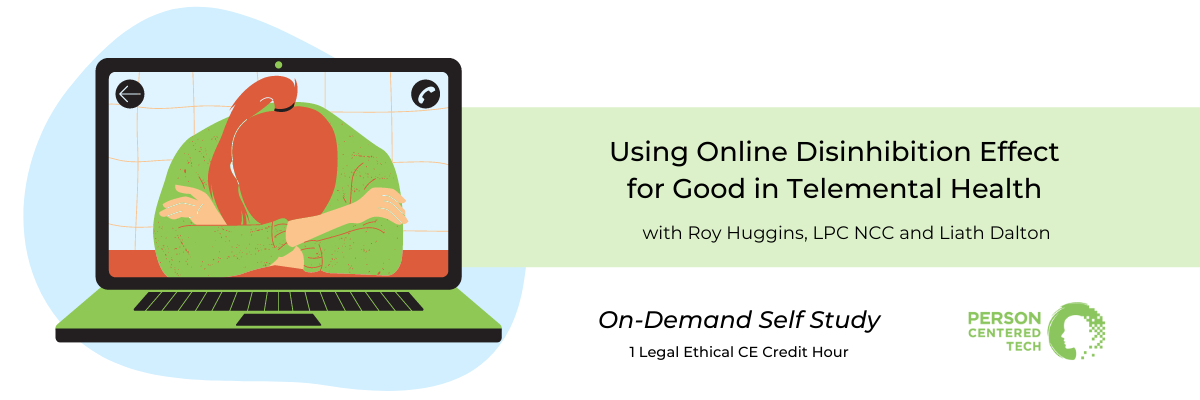Online Disinhibition Effect in Teletherapy Self Study 1 CE credit hours
Using Online Disinhibition Effect for Good in Telemental Health
Join Roy Huggins, LPC NCC and Liath Dalton as they discuss The Online Disinhibition Effect (ODE). As one of the few psychological phenomena that comes up only in computer-mediated interactions, understanding and learning to work with the ODE is essential to effective telemental health work.
1 legal-ethical CE credit hour
On Demand Self Study


Practical Advice Based in Theoretical Grounding
Describe the 6 dimensions of Online Disinhibition Effect

Real World Practice Context
Discuss how Online Disinhibition Effect impacts therapist-client interactions performed via videoconferencing

Application Support
Use Online Disinhibition Effect as a tool to improve the quality of therapeutic interventions performed via videoconferencing

Plus: detailed handouts to reference
Understanding and learning to work with the ODE is essential to effective telemental health work
The Online Disinhibition Effect (ODE) is one of the few psychological phenomena that comes up only in computer-mediated interactions. It arises in conversations on Facebook, when surfing the Web alone, when texting with others, and of course it comes up in telemental health relationships.
The concept was named by cyberpsychology researcher, John Suler, Ph.D. Those experiencing the Online Disinhibition Effect may “…loosen up, feel more uninhibited, express themselves more openly.” (Suler, 2004) This disinhibition can be “benign” and it can be “toxic.” (Suler, 2004)
Similarly, it can benefit therapy and it can detract from therapy. Understanding and learning to work with the ODE is essential to effective telemental health work.
PCT IS MY GO TO RESOURCE for my new fully Teletherapy practice. You all Continue to impress on the Comprehensive and up to date, not to mention User friendly tools and information you provide to therapists etc like myself.
Course Details
This introductory-level course for counselors, clinical social workers, marriage and family therapists, and clinical and counseling psychologists will help learners understand Suler’s description of the 6 factors of Online Disinhibition Effect, how they arise therapy, and how they can cause therapy-interfering problems or therapy-assisting benefits.
Title: Cross-Border Practice in the Age of Telehealth: Interstate and International Mental Health Practice, 2021 Edition
Authors/Presenters: Roy Huggins, LPC NCC; Liath Dalton
CE Length: 2 CE hours
Legal-Ethical CE Hours: 2 legal-ethical CE hours
Educational Objectives:
- Describe the 6 dimensions of Online Disinhibition Effect
- Describe how Online Disinhibition Effect impacts therapist-client interactions performed via videoconferencing
- Use Online Disinhibition Effect as a tool to improve the quality of therapeutic interventions performed via videoconferencing
Syllabus:
- What is the Online Disinhibition Effect and What are Its Factors?
- Dissociative Anonymity
- Invisibility
- Asynchronicity
- Solipsistic Introjection
- Dissociative Imagination
- We’re Equals (minimizing authority)
- How Do the Factors of Disinhibition Relate to Telemental Health Media and Impact Therapy Work via Videoconferencing?
- How the factors classically appear in textual media
- How the factors also appear in videoconferencing
- How Can the Factors of Disinhibition Detriment Therapy via Videoconferencing?
- Loss of close rapport
- Client dissociation or avoidance
- Helping clients avoid negative effects of disinhibition
- How Can the Factors of Disinhibition Benefit Therapy via Videoconferencing?
- Leveraging disinhibition to deepen insight-making
- Using increased transference
Meet Our Presenters
Presented by Roy Huggins LPC, NCC with Liath Dalton

Roy Huggins, LPC NCC, is a counselor in private practice who also directs Person-Centered Tech. Roy worked as a professional Web developer for 7 years before changing paths and makes it his mission to grow clinicians’ understanding of the Internet and other electronic communications mediums for the future of our practices and our professions.
Roy is an adjunct instructor at the Portland State University Counseling program where he teaches Ethics and is a member of the Zur Institute advisory board. He has acted as a subject matter expert on HIPAA, security, and clinical use of technology for Counseling licensure boards, and both state and national mental health professional organizations. He has co-authored or authored 2 book chapters, and he routinely consults with mental health colleagues on ethical and practical issues surrounding tech in clinical practice. He served for 5 years on the board of the Oregon Mental Health Counselors Association and then the Oregon Counseling Association as the Technology Committee Chair.
He really likes this stuff.

Liath Dalton is PCT’s deputy director and a co-owner. Liath is especially passionate about helping therapists be resourced and supported in navigating the security compliance process and identifying the solutions and processes that meet the particular needs of their practices. Liath’s consultation area of expertise is focused on selecting the right combination of services and tech that not only meet the legal-ethical needs of mental health practices, but also the functionality, efficiency, and cost-effectiveness needs as well.
Additional Information
- Petress, K. (n.d.). Power: Definition, Typology, Description, Examples, and Implications [PDF]. San Antonio: University of Texas San Antonio.
- Suler, J. (1999). Psychotherapy in Cyberspace A Five Dimensional Model of Online and Computer-mediated Psychotherapy [PDF]. Author. Retrieved September 27, 2018, from http://www-usr.rider.edu/~suler/psycyber/therapy.html
- Suler, J. (2004). The Online Disinhibition Effect. Retrieved September 27, 2018, from http://www-usr.rider.edu/~suler/psycyber/disinhibit.html
Accuracy, Utility, and Risks Statement: This program is heavily drawn from sources created by one individual, John Suler, and not all of the concepts covered are formally validated by research.
Conflicts of Interest: None.
Commercial Support: None.
This course is subject to our cancellation/refund policy and complaint policy.
